If your dog is fearful of thunder he or she is exhibiting one of the most common phobias that affect dogs.
Dogs also react to lightning, explosive noises, hot-air balloons and many other noises that are part of a dog’s life in a human environment.
If your dog is sensitive to thunder, the nine point plan below will help.
For solutions to noises other than thunder please work through our this page on dog noise phobia solutions

1. Predict the problem
When you compare your dog’s fear of thunder with other noises that may worry it, thunder is different. Thunder is reasonably predictable if you listen to weather forecasts, the radio or look at weather or radar websites.
- They mostly occur in the afternoons and less so in the evenings or overnight
- Weather forecasters over-predict thunderstorms (which is better than under-prediction)
The major problem with thunderstorms is that:-
-
Your dog hears the thunder booms and lightning cracks
-
Your dog will see the ominous darnkess before the storm
-
Your dog will feel the storm if he or she is left outside during a storm
-
And your dog will smell the approach of the storm which is why your dog is so able to predict the storm before you can.
So that means, predict the storm, take action BEFORE the storm, and above all remove your dog from your garden and place in a safe sound-proof location.
2. Be home with your dog
The worst problem is when your dog experiences a thunder fear when you are away from him or her.Your dog will be much more fearful if left alone during a thunderstorm. So, if you have predicted that a storm will occur, be home with your dog at that time if at all possible of have someone care for your dog.
3. Remove your dog from your garden
Dogs left outside during a thunderstorm are much more seriously affected than dogs which are inside. Dogs left outside will attempt to escape form your yard or to ‘inscape’ into your home. While the damage to your fences and your home can be extreme and costly it’s the damage your dog could do to itself that is dangerous – or deadly.
The best location for your dog is the most sound-proof area of your home.

4. Place your dog in a sound-proof Den
You know thunder is noisy, looks scary, smells a lot and your dog will feel it if outside. So an obvious move is to move your dog to a sound-proof room inside your home where he or she will not hear, see, smell and feel the storm.
This room is called a Den and more infomation is available on this member’s file Denning Principle.
Go from room to room to find the most sound-proof location but you are likely to find that:-
- Brick walls are much better at sound proofing than timber walls. Block walls (e.g. Besser block walls) are often the best
- Walk in wardrobes are often very sound proof because they are surrounded by many walls and the texture of your clothes (and the smell of your shoes) may help your dog to be comforted
- Stop firework noise entering through windows of your Den by covering the windows with heavy curtains.
- Foam rubber cut to fit the window cavity is ideal
- Cut an old mattress to fit or visit your local foam rubber shop with the dimensions of the window and they will cut the foam rubber to fit.
- If needed build a sound-proof Den. using sound proof wall cladding. You local hardware store will help with that

5. Use masking noise
Another way of reducing the noise is to mask it by adding other noises to the Den your dog is in. This is the same principle as the music used in shopping centres to mask the noise of activity in the shop.
That can be done by:
- playing a radio or television in the den
- having an air conditioner running
- have a pedestal fan running (that also blows away the odour of the storm)
- or sometimes using a recording of a storm at low volume
6. Use Pheromones and non-medication calmatives
Dog pheromones (called the Dog Appeasing Pheromone or Adaptil) can be very effective for calming noise-fearful dogs with up to 70% effectiveness. The diffuser, the collar and the spray can all be effective but there are different strategies for each.
In addition, the nutritional calmative, Zylkene can be beneficial as well as the homeopathic preparation Homeopet Storm Stress
6. Use Pheromones and non-medication calmatives
Dog pheromones (called the Dog Appeasing Pheromone or Adaptil) can be very effective for calming noise-fearful dogs with up to 70% effectiveness. The diffuser, the collar and the spray can all be effective but there are different strategies for each.
In addition, the nutritional calmative, Zylkene can be beneficial as well as the homeopathic preparation Homeopet Storm Stress
7. Use medication where needed
If your dog is seriously affected, your vet will be able to prescribe medication that may help. Generally speaking a ‘when you need it’ occasional use medication can be helpful but ..
- Ask your vet to avoid heavy tranquilisers if possible – some tranquilisers can make dogs more sensitive to noises
- You MUST test the dose needed BEFORE the event to know:-
- what dose is effective
- how long it takes to work and
- how long it lasts for
That will allow you to use the right dose long enough before the fireworks to help your dog. Some pet owners find that Homeopet Storm Stress preparations are useful.
Combining Adaptil pheromones with Homeopet Storm Stress provides science-based solutions for dogs suffering fear of thunder and fireworks and gives a double-up benefit that can provide the most powerful non-medication approach to noise fear solutions. We now have Noise Fear Packs available to help.
8. Practice calming strategies
When your dog is panicking, it needs to develop a calm demeanour.
Thus, your job is to do whatever you need to do to create calmness.
Sometimes that DOES mean giving the dog comfort and attention when it’s panicking. Many advise that ‘praising the fear’ by giving a panicking dog attention rewards the panic.
This is nonsense.
A panicking dog is not able to learn. He or she is far too ‘emotional’ to consider you may be rewarding its fear.
You may be able to calm your dog by:-
- Using calming massage concentrating on the major muscle groups such as the cheek, forehead, neck and shoulder muscles (a video is available here)
- Using firm finger-tip massage doing a circle about the size of a 50 cent piece. Use your thumb and index finger in tandem
- Using a novel device called a Calming Cap in combination with a Gentle Leader
- these two devices used together can have a significant calming effect on dogs but your dog needs to be trained to happily accept both before the firework event
- Wrapping your dog’s body tightly with a towel
- Giving your dog a firm hug around his or her chest
- And showing your dog YOU are calm by:-
- cradling your dog’s face in your hands as if it was a football and make it look at you
- then blinking your eyes as if you were falling asleep
- show a soft smile (and certainly not a worried expression)
- and whispering to your dog is the softest whisper you can manage.
9. Teach your dog to tolerate thunder noise
Desensitising your dog to the noise of thunder is often possible using quality recordings of thunder. These recordings are incorporated into the Frightful Noises Audio CD.
There are more details on this process on this facts sheet Noise Annoys Frightful Noises but a summary is:-
- Determine if the recording, when played through your audio equipment, does alarm your dog but do this once only.
- If so, expose your dog to a level of the recording that causes NO fear and repeat that daily for a few days.
- Then incrementally increase the volume of the noise daily while ensuring your dog remains calm and content.
- Once successful, the same noise tracks can be used mask the noise of thunder as detailed in section 5 above.
- If the recording played through your audio equipment does NOT alarm your dog, then you can immediately move to using this as a masking (see section 5).
Solving fear of noises is very complex and difficult. If you want personal assistance with this problem please contact our consulting rooms on (07) 3341 9153 or complete an assessment form that you will find linked to the menu above.

